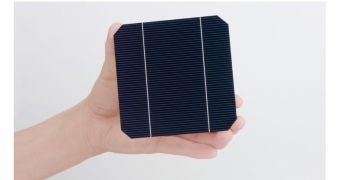Solar power is becoming an increasingly important subject nowadays, as it might hold a very important role in mankind's future development. This completely renewable and green energy can only be harnessed by using photovoltaic solar cells, but said cells are still very far from achieving a reasonable energy efficiency level. However, hopes are quite high, especially after Sanyo has announced today that it managed to develop the world's most efficient solar cells.
Thus, according to the company's statement, the results obtained by Sanyo's R&D department represent the first time that a photovoltaic manufacturer has broken through the 22% mark in conversion efficiency at the research-level for practical-sized solar cells. Moreover, the increase in the solar cell conversion efficiency is accompanied by significant advances in lowering the production cost of the photovoltaic system and the reduction in the use of raw materials such as silicon.
Sanyo's HIT (Heterojunction with Intrinsic Thin layer) solar cells consist of a single thin crystalline silicon wafer surrounded by ultra-thin amorphous silicon layers. The intrinsic structure of the HIT solar cell allows it to reduce the recombination loss of the electrical element (charged carrier) by surrounding the energy generation layer of single thin crystalline silicon (c-Si) with high quality ultra-thin amorphous silicon (a-Si) layers.
In order to achieve the highest level of efficiency, the researchers from Sanyo developed two special technologies, one for cleaning the c-Si surface and the other for protecting the c-Si surface from damage during construction of the a-Si layer. And it seems that the results were more than satisfactory, since the open circuit voltage (Voc) was increased from 0.718V to 0.722V.
And since we're talking about the features of HIT solar cells, let's take a look at the other specs it has to offer:
- Open circuit voltage (Voc): 0.722V; - Short circuit current (Isc): 3.872A (38.64mA/cm2); - Fill factor (FF): 78.8%; - Cell energy conversion efficiency: 22.0%; - Cell size: 100.2cm2.
This very important breakthrough might have some serious effects in the future, as it might decrease the overall costs of manufacture for solar cells, and thus help in the dissemination of this technology among consumers.
We are just a few, but there are many of you, Softpedia users, out there. That's why we thought it would be a good idea to create an email address for you to help us a little in finding gadgets we missed. Interesting links are bound to be posted with recognition going mainly to those who submit. The address is  .
.

 14 DAY TRIAL //
14 DAY TRIAL //